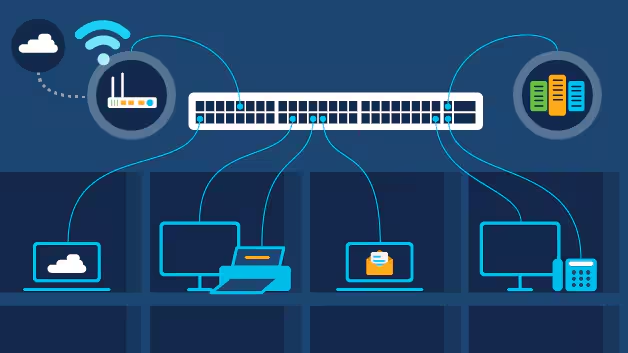Key Takeaways:
Ethernet switching is a crucial technology that enables efficient and effective communication between devices in a network. It sends and receives data seamlessly, ensuring smooth operations within a digital environment. Modern networks rely heavily on Ethernet switching to support high-speed internet, facilitate data transfer, and maintain reliable connections in small- and large-scale infrastructures.
Table of Contents:
- Introduction
- Understanding Ethernet Switching
- Components and Operation of Ethernet Switches
- Different Types of Ethernet Switches
- Importance of Ethernet Switching in Modern Networks
- Benefits of Ethernet Switching
- Conclusion
Introduction
The digital age has increased demand for fast and reliable communication networks. As businesses and individuals increasingly rely on digital connectivity, understanding the technologies that underpin network infrastructure becomes critical. Among the most essential of these technologies is Ethernet switching. Ethernet switching is pivotal in efficiently managing and directing data traffic across networks, facilitating uninterrupted, high-speed communications vital for modern operations. This article explores the intricacies of Ethernet switching and its significance in today’s digital environment.
Understanding Ethernet Switching
At its core, Ethernet switching is a network technology that manages data flow across a network by processing and forwarding data packets to their intended destination. This technology functions as a traffic director within a network, ensuring that data packets travel along the most efficient paths to reach their endpoints. An ethernet switch is a central hub within the network, connecting multiple devices such as computers, printers, and servers, allowing them to communicate via data packet exchanges. Using Ethernet switches, networks can facilitate simultaneous communication between devices while minimizing data collisions and ensuring efficient bandwidth utilization.
Components and Operation of Ethernet Switches
Ethernet switches comprise several key components that work in unison to manage data traffic. The primary component is the switching fabric, an internal network within the switch that interconnects its various ports and manages the path taken by data packets. The switching fabric performs the critical task of directing data from an incoming port to the correct outgoing port, facilitating the rapid exchange of information between connected devices.
Ethernet switches operate through a process known as switching. When a device sends data across the network, the data is divided into smaller units called Ethernet frames. The switch receives these frames, which examine their headers to determine the destination device. By employing a MAC address table—a database of all known devices connected to the network—the switch efficiently forwards the frames to the appropriate devices, avoiding unnecessary transmissions and reducing network congestion.
Different Types of Ethernet Switches
Ethernet switches come in various types, each tailored to specific networking requirements and environments. Understanding these types is essential for selecting the right switch that aligns with particular network needs:
Unmanaged Switches: These switches offer basic connectivity with minimal configuration options. They are typically used in small networks or home environments with unnecessary advanced management features. Unmanaged switches provide plug-and-play functionality, allowing devices to be connected with minimal setup effort.
Managed Switches: Managed switches offer more advanced features and greater control over network settings. They enable network administrators to configure, manage, and monitor network performance through a user or command-line interface. Managed switches are ideal for large or complex networks where precise control over data traffic and security settings is required.
Smart Switches: Positioned between unmanaged and managed switches, smart switches provide enhanced features without the complexity of fully managed switches. They typically offer a limited set of management options, making them suitable for organizations that need some level of control without the complexity of full management.
PoE (Power over Ethernet) Switches:These switches can deliver electrical power to connected devices, such as IP cameras or wireless access points, using the same Ethernet cables that transmit data. PoE switches simplify installations by eliminating the need for separate power sources for specific devices.
Importance of Ethernet Switching in Modern Networks
Ethernet switching is imperative for maintaining efficient and effective network operations in modern environments. One of its primary advantages is its ability to reduce network congestion by intelligently directing data traffic. By ensuring that data packets travel to their designated destinations through optimal pathways, Ethernet switches minimize the occurrences of data collision and delay, thereby enhancing network performance.
Furthermore, Ethernet switching enables the scalability of network infrastructures. As organizations grow and their network needs evolve, Ethernet switches provide the flexibility to expand network capacity by adding new devices without compromising speed or efficiency. This adaptability is crucial in today’s fast-paced digital landscape, where businesses must be ready to accommodate growing data connectivity and communication demands.
Benefits of Ethernet Switching
The utilization of Ethernet switching in network infrastructure offers several tangible benefits, making it an indispensable component of modern networking:
Enhanced Efficiency: Ethernet switches improve network efficiency by optimizing data frame forwarding, ensuring that only necessary data is transmitted across the network. This efficiency translates to faster data transfer rates and improved overall network performance.
Improved Security: Managed Ethernet switches allow network administrators to configure security settings such as VLANs (Virtual Local Area Networks) and access control lists, enhancing network security by restricting unauthorized access to sensitive information.
Flexibility and Scalability: Ethernet switches facilitate network expansion and scalability, allowing organizations to add new devices and users as needed easily. This capability is particularly beneficial for growing businesses that need to scale their networks in response to increasing demands.
Ethernet switching supports enterprise-level communications, enabling organizations to maintain continuous, efficient, and secure connectivity across their digital operations.
Conclusion
In conclusion, Ethernet switching is a fundamental component of modern network infrastructure. By understanding and leveraging this technology, organizations can ensure efficient, reliable, and scalable communications essential for success in today’s digitally driven world. As the demand for high-speed connectivity and data transfer continues to rise, Ethernet switching will remain a critical technology, facilitating seamless interactions and maintaining smooth operations across diverse digital environments. Its ability to enhance network performance while providing robust management and security features ensures that Ethernet switching remains at the forefront of networking technology advancements.






